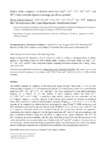Mostrar o rexistro simple do ítem
Highly stable complexes of divalent metal ions (Mg2+, Ca2+, Cu2+, Zn2+, Cd2+, and Pb2+) with a dota‐like ligand containing a picolinate pendant
| dc.contributor.author | Regueiro-Figueroa, Martín | |
| dc.contributor.author | Ruscsák, Erika | |
| dc.contributor.author | Fra, Laura | |
| dc.contributor.author | Tircsó, Gyula | |
| dc.contributor.author | Tóth, Imre | |
| dc.contributor.author | Blas, Andrés de | |
| dc.contributor.author | Rodríguez-Blas, Teresa | |
| dc.contributor.author | Platas-Iglesias, Carlos | |
| dc.contributor.author | Esteban-Gómez, David | |
| dc.date.accessioned | 2018-11-26T14:05:43Z | |
| dc.date.available | 2018-11-26T14:05:43Z | |
| dc.date.issued | 2014-12 | |
| dc.identifier.citation | Regueiro‐Figueroa, M., Ruscsák, E., Fra, L., Tircsó, G., Tóth, I., de Blas, A., Rodríguez‐Blas, T., Platas‐Iglesias, C. and Esteban‐Gómez, D. (2014), Highly Stable Complexes of Divalent Metal Ions (Mg2+, Ca2+, Cu2+, Zn2+, Cd2+, and Pb2+) with a Dota‐Like Ligand Containing a Picolinate Pendant. Eur. J. Inorg. Chem., 2014: 6165–6173. | es_ES |
| dc.identifier.issn | 1434-1948 | |
| dc.identifier.issn | 1099-0682 | |
| dc.identifier.uri | http://hdl.handle.net/2183/21357 | |
| dc.description.abstract | [Abstract] The stability constants of complexes of the macrocyclic ligand do3a‐pic4– (H4do3a‐pic = 2,2′,2″‐{10‐[(6‐carboxypyridin‐2‐yl)methyl]‐1,4,7,10‐tetraazacyclododecane 1,4,7‐triyl}triacetic acid) with several divalent metal ions (Pb2+, Cd2+, Zn2+, Cu2+, Ca2+, and Mg2+) have been determined by using pH‐potentiometric titrations (I = 0.1 M KCl, 25 °C). The stability of these complexes follows the trend Cu2+ > Cd2+ ≈ Pb2+ ≈ Zn2+ >> Ca2+ >> Mg2+. A particularly high stability constant has been determined for the Cu2+ complex [log KCuL = 23.20(4)]. Analysis of the titration curves indicate the presence of protonated forms of the complexes in solution, with protonation constants of log KM(HxL) = 6.9–2.0 (x = 1, 2, or 3). The structure of the complexes in solution has been investigated by using 1H and 13C NMR spectroscopy and DFT calculations performed in aqueous solution at the TPSSh/6‐31G(d) level. In the case of the Pb2+ and Cd2+ complexes, relativistic effects were considered with the use of relativistic effective core potentials. Calculations show that the complexes with the largest metal ions (Pb2+ and Ca2+) are nine‐coordinate, with their coordination polyhedra being best described as capped twisted square antiprisms. The Cd2+ and Mg2+ complexes are seven‐coordinate, with the metal ions being bound to the four nitrogen atoms of the cyclen unit and the three acetate pendant arms. Finally, in the Cu2+ and Zn2+ complexes, the metal ions are six‐coordinated, with the metal ions being asymmetrically placed inside the macrocyclic cavity of the ligand, and the coordination polyhedra can be described as an octahedron and a trigonal prism, respectively. | es_ES |
| dc.description.sponsorship | Xunta de Galicia; CN 2012/011 | es_ES |
| dc.description.sponsorship | Xunta de Galicia; EM 2012/088 | es_ES |
| dc.description.sponsorship | Hungarian Scientific Research Fund; OTKA K‐8429 | es_ES |
| dc.description.sponsorship | Hungarian Scientific Research Fund; OTKA K‐109029 | es_ES |
| dc.description.sponsorship | European Commission; TÁMOP-4.2.2A-11/1/KONV-2012-0043 | es_ES |
| dc.language.iso | eng | es_ES |
| dc.publisher | Wiley | es_ES |
| dc.relation.uri | https://doi.org/10.1002/ejic.201402693 | es_ES |
| dc.rights | This is the peer reviewed version of the following article: Regueiro‐Figueroa, M., Ruscsák, E., Fra, L., Tircsó, G., Tóth, I., de Blas, A., Rodríguez‐Blas, T., Platas‐Iglesias, C. and Esteban‐Gómez, D. (2014), Highly Stable Complexes of Divalent Metal Ions (Mg2+, Ca2+, Cu2+, Zn2+, Cd2+, and Pb2+) with a Dota‐Like Ligand Containing a Picolinate Pendant. Eur. J. Inorg. Chem., 2014: 6165–6173, which has been published in final form at https://doi.org/10.1002/ejic.201402693. This article may be used for non-commercial purposes in accordance with Wiley Terms and Conditions for Use of Self-Archived Versions. | es_ES |
| dc.subject | Macrocycles | es_ES |
| dc.subject | Macrocyclic ligands | es_ES |
| dc.subject | Lead | es_ES |
| dc.subject | Copper | es_ES |
| dc.subject | Cadmium | es_ES |
| dc.title | Highly stable complexes of divalent metal ions (Mg2+, Ca2+, Cu2+, Zn2+, Cd2+, and Pb2+) with a dota‐like ligand containing a picolinate pendant | es_ES |
| dc.type | info:eu-repo/semantics/article | es_ES |
| dc.rights.access | info:eu-repo/semantics/openAccess | es_ES |
| UDC.journalTitle | European Journal of Inorganic Chemistry | es_ES |
| UDC.volume | 2014 | es_ES |
| UDC.issue | 36 | es_ES |
| UDC.startPage | 6165 | es_ES |
| UDC.endPage | 6173 | es_ES |
Ficheiros no ítem
Este ítem aparece na(s) seguinte(s) colección(s)
-
GI-REACT! - Artigos [113]






